Schuilkerken (hidden churches) in the Time of Vermeer
1. A short history of the hidden church of Vermeer's marriage in Schipluiden-Hodenpijl
2. A guided tour of Schipluiden
3. Two documents concerning the marriage of Johannes Vermeer and Catharina Bolnes
Whenever we read about Vermeer's life and the specific circumstances of his marriage we must remember that many open questions remain. One of the most intriguing concerns the painter’s presumed conversion to Roman Catholicism.1 This hypothesis relies largely on circumstantial evidence related to his marriage to Catharina Bolnes although it is supported as well by other facts which occur in later years of the artist’s family life. Some historians conjecture that Vermeer embraced his new faith with enthusiasm and that this reflects itself in his painting while most take a more cautious position. Such intimate interpretation of Vermeer's unobtrusive compositions proves tricky at best. While it is true that the Allegory of Faith is an allegory of the true and heretical faith, this does not mean the subject was Vermeer’s own choice. The work could have easily been commissioned. In any case, as far as we know, Vermeer seemed to have guided his new family life under the sign of Catholicism, or at the very least, he did not place any obstacles in the way of those who wished to do so.
Vermeer's Marriage
We know for certain that Vermeer’s wife, Catharina Bolnes, came from a wealthy patrician family of Gouda deeply devoted to the Roman Catholic faith. Her mother, Maria Thins, had close connections to the Jesuit order in particular. Today, following the suppositions by John Michael Montias, all parties agree that Vermeer's marriage ceremony with Catharina Bolnes (20th April 1653) took place in Schipluy (today: Schipluiden), a village south-west from Delft on the river Gaag. But not a single shred of evidence has surfaced which might suggest in which church this ceremony took place.2
Indeed, a parish in Schipluiden had been mentioned as early as 12th May 1294. But after the Reformation had swept the Netherlands in the middle of the 16th century, it had been handed over to the Calvinistic Reformed Church (Gereformeerde Kerk, since 1816 Hervormde Kerk) which had become the official church in the Netherlands. Catholics no longer were allowed to celebrate the Holy Mass, baptisms, marriages or burials in public. Nevertheless, the Catholic faith, as in other cities in the Netherlands, continued to be tolerated by Schipluiden public officials. One of the town’s eldermen remained true to the old faith.
In which church did Johannes Vermeer and Catharina Bolnes marry, if in 1653 Schipluiden’s only church had been a Reformed one for one hundred years (and still is today)? What did it look like? And are there any traces of it to be found today? This study attempts to find answers to these questions.
Schipluiden
Schipluiden was constituted by several small villages with farmsteads and small workshops. These were Dorp, St. Maartensrecht, t'Woudt, Groeneveld, Hof van Delft, Hodenpijl and Zouteveen. Each had their own board and justice, tax rules and local culture. Such rural dominions (heerlijkheden) were more or less independent from the other. Usually they belonged to the estate of a local count. In a document of 1083, signed by a Count Dirk the Fifth, the name "Schipleda" had been mentioned for the first time. The name probably meant the canal "Sciplede" for the regulation of the flow of water, indispensable during periods of flooding. In a letter of 1450 by Duke Philip of Burgundy to the city of Delft, the name "Schipluyden" appears, quite similar to the present-day spelling. It could be translated as "ship [bell's] ringing," perhaps deriving from the ships which signaled their passage through the area’s watergates.
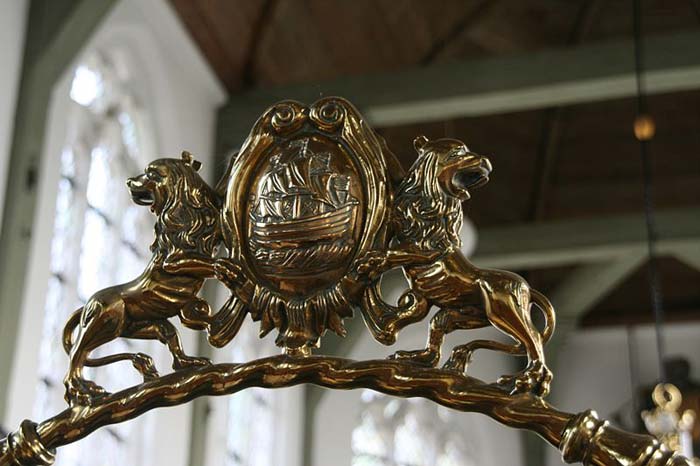
One of the oldest representations of the emblem of Schipluiden is to be found in the local Nederlands Hervormde Kerk, at an arched brass grid from 1702 over the baptismal font, as well as on one of the consoles in the church. It shows a ship
from the 17th century, in full sail, like it was used for the big trips to East India.
As mentioned, after the Reformation in the Netherlands, the Catholic parish of Schipluiden had been confiscated by the official Calvinistic Reformed Church, and Roman Catholics were no longer allowed to hold any sort of service within an official building. The grounds of the local church, the oldest building in Schipluiden, still incorporates bricks from the earlier and smaller church, probably those of a cloister.
Nevertheless, Schipluiden became a center for the Catholic faith for those peasants the area who refused to give up their old faith. This may have been owed to the missionary work by the Jesuit Cornelis Jacobsz. Duyst who, in 1592, resided in the Bagijnhof in Delft where he founded the first Jesuit mission.3
Schuilkerken
Although the founding father of the United Provinces, William the Silent, had championed religious and cultural tolerance, in practice, Calvinists were openly hostile towards people of different faith and attitude. Only foreigners, like Jews emigrated from other countries, were able to practice their religion freely, without significant restrictions. But Catholics, Remonstrants and Mennonites were explicitly forbidden to practice their faith in the public. They were violently deprived of their churches, cloisters, grounds and were forced to take refuge within domestic walls, warehouses, cellars, attics and even barns. These environments were then rebuilt and decorated for the purposes of celebrating the Holy Masses and holding other religious meetings evolving into so-called schuilkerken (hidden churches). In the rural areas they were called schuurkerken (Dutch schuur = barn) since barns were frequently used for the purpose. Initially, Calvinistic authorities reacted harshly against these hidden churches. In Zwolle, for instance, Catholic families were forbidden to live in houses side by side in order to impede them from tearing down the walls to create a room large enough for a church.
But in the course of the time, the schuilkerken gradually became tolerated by officials. However, it was strictly prohibited that their entrances could be accessed directly from the street and no sign (crucifixes or other Christian symbols) could be placed above the entrances. Even bell towers were banned because they could have pointed to the existence of a building of religious use other than the Reformed one. Bell-ringing was completely forbidden. Furthermore, no congregational singing was permitted to be heard from outside. Nevertheless, hidden churches quickly spread all over the country, particularly in the protestant Seven United Provinces.4
The schuilkerkje in Hodenpijl
 The location of the schuilkerk in Hodenpijl
The location of the schuilkerk in Hodenpijl
(probably the single house above) in a drawing by Johann van Beest, 1634.
Since Catholics who resided in the countryside did not generally inhabit the central areas of the villages, but rather in the small peasantries around them, the members of the Roman-Catholic parish of Schipluiden found it necessary to select for a suitable place for worship. It had to be within easy reach from Maasland, Maasluis, Den Hoorn, Abtswoude, De Lier and t'Woudt (in this case mainly by boat). Hodenpijl, between Schipluiden and Den Hoorn, directly at the river Gaag, at the "smalle kant" ("small side", present Tramkade) was chosen.
With the aid of a donation by a wealthy Catholic woman, a certain "Jouffrouw van Hoeven," a barn was constructed and furnished for the religious practices and meetings of the faithful. This first schuilkerkje (or better schuurkerkje) was dedicated to Ignatius of Loyola, the founder of the Jesuit order. It became the center of the Catholic faith in Schipluiden and the surrounding area.5 As said above, it was always tolerated by the local officials, since some of them remained true to their old faith despite the rule that everyone who held public office was required to convert to the Reformed faith.
The hidden church in Hodenpijl was mentioned for the first time in 1657, four years after Vermeer's marriage with Catharina Bolnes, and it was the place where they had been married even though it was nothing more than a barn.6 Twenty-one years later, in June 1674 the eldest daughter of Johannes and Catharina, Maria Vermeer, was also married in Schipluiden – certainly in the same little schuilkerkje in Hodenpijl, where she married the Catholic silk-salesman, (zijdekoopman) Johannes Gilleszn. Cramer from Delft.
In 1722, a fire caused severe damages to both the church and to the nearby cottage where the priest lived. The church was restored, and a new residence for the priest was provided in a building called "De Herdershof"" on the opposite side of the Gaag, the "brede kant" ("broad side", present Rijksstraatweg).
The Oude Kerk in Hodenpijl
With the relaxation of the strict regulations for Catholics during the Napoleonic occupation and the short period of the Kingdom of Holland (1806-1810) Catholic parishes acquired the right to rebuild and extend places of worship or even to build new ones. The parish of Schipluiden raised a tower housing one bell above its little church, and attached stable side walls with real church windows. But with the increasing population it became too small, and in 1839 the parish council decided to build a larger church on the opposite side of the Gaag, where the "Herdershof" was originally situated. Soon after, on 13th October 1840 the new church could be dedicated to St. Jacobus. It was built as a so-called "waterstaatskerk" (derived from the "Ministerie van Waterstaat" which had to approve for the building) in Classical style. The facade was given the typical shape of an ancient Greek temple, since the culture of the Greek antiquity was highly esteemed in the 19th century. Some time after dedication of the new St. Jacobus church, the little old schuilkerkje was demolished.
The church was in use until 1963. But after the Second World War, the number of the regular followers of the Masses in Hodenpijl declined. In addition, Den Hoorn raised its own Catholic church in 1917 in order to provide a more comfortable solution for its inhabitants. The Catholics of Schipluiden desired a new church as well. So the last Holy Mass in the "Oude Kerk" in Hodenpijl (related now to the new one in Schipluiden), the predecessor of that little schuilkerkje Vermeer had been married three hundred years ago, took place on 15th December 1963. The building was sold to a company in Den Haag.
Since 2004 the church, together with the parsonage "De Herdershof," and the garden is a part of a private estate whose aim is to create a cultural center for the region Midden-Delfland (the fusion of Schipluiden and Maasland in 2004).
Private efforts provided enormous help for the extensive restoration of both the church and the parsonage with its lovely garden, until the new center "Op Hodenpijl" opened its doors on 17th May 2007 (Ascension Day). The new church became a meeting point for the local inhabitants, providing a convenient environment for lectures and discussions about the region and its specialities, concerts or local feasts. Contemporarily, it offers an excellent chance for foreigners to discover this area immersed in the polders, its cultivation and the special techniques of water regulation, and last but not least, it is a lovely point both for relaxing and discovering the poetic landscape near Delft.
take a guided tour of Schipluiden-Hodenpijl
The location of the schuilkerk in Hodenpijl
(probably the single house above) in a drawing by Johann van Beest, 1634.
Birds-eye-view on Oude Kerk in Hodenpijl at the Gaag (left side) with the little iron-wrought bridge from 1859 for the churchgoers from the other side of the river (see also below). It leads to that place (right side) where the former schuilkerkje was situated. The image still shows the church without the tower which was pulled down in 1972. But thanks to the extensive restoration the church got back its tower in summer 2007.
The approximate location, opposite to Oude Kerk (present Tramkade), of the former schuilkerkje where Vermeer had been married. No traces have been left, but the development from this little hidden church (with the only known picture of it, see above) to the former Oude Kerk can be followed in an exhibition in the church, and it is still mentioned in local publications.
The Oude Kerk at present Rijksstraatweg (next to no. 18), after the extensive restoration 2004-2007. It was designed 1838 by architect A. Rodenburg (Den Haag) as a so-called "waterstaatskerk," with the façade in the shape of an ancient Greek temple. In the 19th century the ancient Greek culture was held in great esteem also
in the Netherlands. Since summer 2007 the church has regained its small tower with the typical rounded cupola.
The former parsonage De Herdershof, next to Oude Kerk. The building as it appears today originates from 1872 and, together with the Oude Kerk, serves as a contemporary witness of the social and religious climate in the area especially in the period 1840-1870
It was the residence of the priest, together with additional rooms for daily Masses or meetings in a rather "private" circle. Today it is the location of the management of the foundation "Op Hodenpijl" and offers suitable rooms for activities of smaller groups. Both Oude Kerk and "De Herdershof" are surrounded by a lovely garden with traces from the former little cemetery of the parish.
View towards the Oude Kerk in Hodenpijl from the opposite bank of the Gaag (Tramkade), when coming from Schipluiden.
The interior of Oude Kerk. Thanks to the very cautious, sensitive restoration the room appears full of light floating through the decent stained-glass windows. The ceiling is tastefully decorated with frescoes, partly in trompe-l'oeil-technique. Today the room serves for a variety of activities, like lectures (frequently with multi-media support), concerts, various local meetings or festivities, or merely as a place for some meditating and enjoying the silence
This image shows the iron-wrought bridge from 1859 which connects the place of the former schuilkerkje (see the following image) with its successor, the Oude Kerk. Between 1822 and 1883 the churchyard of the parish was still situated at the "smalle kant" (present Tramkade) near the schuilkerkje, and the priest, residing in "De Herdershof" at the opposite side, had always to take the boat to celebrate the Masses there or to visit the faithful
living at the "smalle kant". With the building of the Oude Kerk the bridge served also as a more comfortable facility for the people from the opposite side to visit the church. The bridge is now a technical monument of the 19th century and still shows traces from the times of the trekschuiten, those small boats which Vermeer rendered so carefully in his magnificent View of Delft.
The only known image of the schuilkerk in Hodenpijl as it appeared c. 1822. In this year the Catholic parish Schipluiden got the permission to build a little tower (with one bell) and side walls with real church windows.
The former Oude Kerk in Hodenpijl at the east side of the Gaag (presently Rijksstraatweg). Watercolor, 1860.
-
See above all John Michael Montias, Vermeer and His Milieu: A Web of Social History
, chapter 6: "Apprenticeship and Marriage", 98-107, Princeton, New Jersey 1989; Paul H.A.M. Abels, "Church and religion in the life of Johannes Vermeer", Dutch Society in the Age of Vermeer, ed. Donald Haks and Marie Christine van der Sman, 68-77, and Montias' reaction hereupon in "Recent Archival Research on Vermeer", note 77, Vermeer Studies
, ed. Ivan Gaskell, Michiel Jonker, New Haven and London 1998, 108.
- Montias (1989, 101) at least mentions a "hidden church in Schipluy".
- Abels op. cit. 68.
- The most famous of these schuilkerken is certainly the so-called "Ons" Lieve Heer op Solder" ("Our Lord in the Attic"),
http://www.museumamstelkring.nl/onslieveheeropsolder/eng/home.php
a comparatively large, splendidly furnished church-room comprising the entire attic of a prestigious property bought in 1661 by the wealthy merchant Jan Hartman in Amsterdam with the aim to offer the Catholics in the city center a secret room to celebrate the Holy Mass, which then served as a parish church for over two hundred years. After thorough research and restoration the house has become in 1888 the present Amstelkring-Museum with highly interesting insights into 17th-c. life and faith. After the Rijksmuseum it is Amsterdam's oldest museum.
- Information from a book about churches in the area of Schipluiden, available in the present cultural center for Midden- Delfland "Op Hodenpijl", http://www.ophodenpijl.nl/
located in the former Oude Kerk in Hodenpijl (see in the following).
- See in the history of the Roman-Catholic church in Hodenpijl (Dutch only). Text: Jacques Moerman, Historische Vereniging Oud-Schipluiden, September 2004.
http://cultuur.middendelfland.net/rkkerkhodenpijl/geschiedenis.htm

This map from 1866 shows the location of Schipluiden in an area of polders south-west from Delft, together with the surrounding small villages, among others Hodenpijl at the river Gaag, half way from Den Hoorn (to the north) to Schipluiden (center of the map).
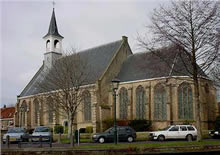
The Nederlands Hervormde Kerk in Schipluiden, as it appears today. A considerable enlargement was made in c. 1500. Extensive restorations followed after the large fire from 28th August 1616 which left the church, the parsonage and the schoolhouse severely damaged, as well as in the 19th and 20th century.
For details to its history see in "Cultuurhistorie Midden-Delfland" (Dutch only).
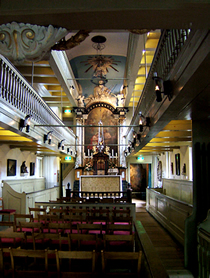
Interior of the former hidden church Ons Lieve Heer op Solder, complete with galleries providing more space for the increasing number of believers and an organ from 1794 at the backfront of the gallery, still regularly played.
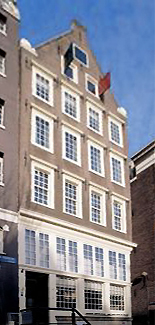
The Amstelkring-Museum in Amsterdam, at Oudezijds Voorburgwal, with various rooms completely furnished in 17th- and 18th- style and the famous former hidden church "Ons" Lieve Heer op Solder" ("Our Lord in the Attic", see note 4). The magnificent collection of paintings, sculpture and silver provides an impressing overview of Catholic history in Amsterdam.
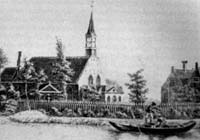
The only known image of the schuilkerk in Hodenpijl as it appeared c. 1822. In this year the Catholic parish Schipluiden got the permission to build a little tower (with one bell) and side walls with real church windows.
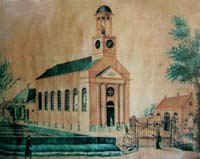
The former Oude Kerk in Hodenpijl at the east side of the Gaag (present Rijksstraatweg). Watercolor, 1860.
Two Documents Related to the marriage of Johannes Vermeer and Catharina Bolnes
Record of Leonaert Bramer's and Captain Melling's Appeal to Maria Thins
5 April 1653.
Op huijden den 5den april 1653 compareerde voor mij Johannes Ranck openbaer notaris...binnen der stadt Delft residerende in presentie van de ondergeschreven getuijgen, Capiteyn Melling out ontrent LIX jaeren ende Leonart Bramer schilder out ontrent LVIII jaeren beyde burgers alhier, die verclaerden ende attesteerden ten versoucke van Jan Reijniersz. ende Trijntgen Reijniers waerachtich te weesen dat sij getuijgen neffens mijn notaris gisteren avont sijnde den IIII den deser sijn geweest ten huijse aen ende bij de persoon van Joffrouwe Maria Tints woonende alhier ...
signed:
B. Melling (left-side) Leonaert Bramer (right-side)
(akten notaris J. Ranck, no. 2112)
Montias entry 249
Record of the Marriage of Johannes Vermeer and Catharina Bolnes
5 en 20 april 1653. Den 5en Apprill 1653: Johannes Ryniersz. Vermeer J[ong] M[an] opt
Marctvelt, Catharina Bolenes J[onge] D[ochter] mede aldaar.
[margin note left-side:] Attestatie gegeven in Schipluijden 20 April 1653
5 and 20 April 1653. In the "register of the persons who entered the holy marital state in the town of Delft, beginning with the year 1650, ending 'last' [31st] December 1656":
"Johannes Reijniersz. Vermeer, bachelor [living] on the Market Place; Catharina Bolenes,
young daughter [spinster], also there."
[marginal note left-side:] Attestation given in Schipluij, 20 April 1653".
Montias entry 250














